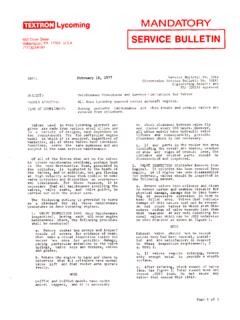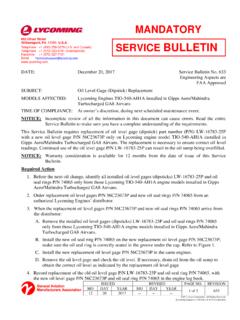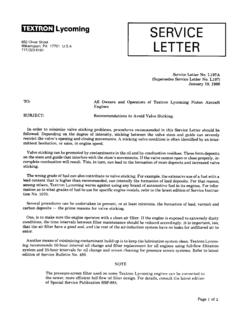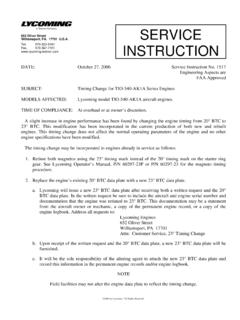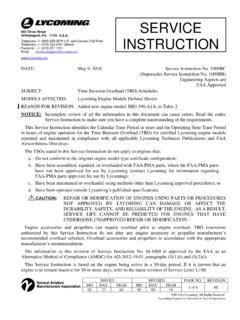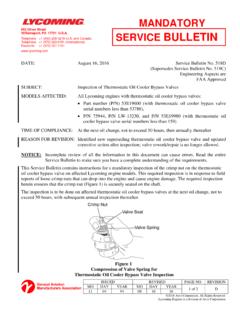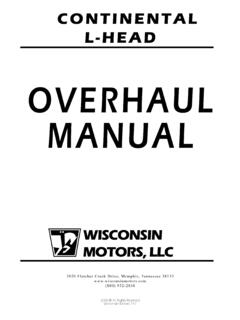Transcription of O-235 and O-290 Series - Lycoming Engines
1 Operator's Manual Lycoming O-235 and O-290 Series Approved by FAA. 5th Edition Part No. 60297-9. January 2007. 652 Oliver Street Williamsport, PA. 17701 570/323-6181. O-235 and O-290 Series Operator's Manual Lycoming Part Number: 60297-9. 2007 by Lycoming . All rights reserved. Lycoming and Powered by Lycoming are trademarks or registered trademarks of Lycoming . All brand and product names referenced in this publication are trademarks or registered trademarks of their respective companies. For additional information: Mailing address: Lycoming Engines 652 Oliver Street Williamsport, PA 17701 Phone: Factory: 570-323-6181. Sales Department: 570-327-7268. Fax: 570-327-7101. Lycoming 's regular business hours are Monday through Friday from 8:00 AM. through 5:00 PM Eastern Time (-5 GMT). Visit us on the World Wide Web at: Lycoming OPERATOR'S MANUAL. ATTENTION.
2 OWNERS, OPERATORS, AND MAINTENANCE PERSONNEL. This operator's manual contains a description of the engine, its specifications, and detailed information on how to operate and maintain it. Such maintenance procedures that may be required in conjunction with periodic inspections are also included. This manual is intended for use by owners, pilots and maintenance personnel responsible for care of Lycoming powered aircraft. Modifications and repair procedures are contained in Lycoming overhaul manuals; maintenance personnel should refer to these for such procedures. SAFETY WARNING. NEGLECTING TO FOLLOW THE OPERATING instructions AND TO CARRY OUT PERIODIC. MAINTENANCE PROCEDURES CAN RESULT IN POOR ENGINE PERFORMANCE AND POWER. LOSS. ALSO, IF POWER AND SPEED LIMITATIONS SPECIFIED IN THIS MANUAL ARE EXCEEDED, FOR ANY REASON; DAMAGE TO THE ENGINE AND PERSONAL INJURY CAN HAPPEN.
3 CONSULT. YOUR LOCAL FAA APPROVED MAINTENANCE FACILITY. SERVICE BULLETINS, instructions AND LETTERS. Although the information contained in this manual is up-to-date at time of publication, users are urged to keep abreast of later information through Lycoming Service Bulletins, instructions and Service Letters which are available from all Lycoming distributors or from the factory by subscription. Consult the latest revision of Service Letter No. L114 for subscription information. SPECIAL NOTE. The illustrations, pictures and drawings shown in this publication are typical of the subject matter they portray; in no instance are they to be interpreted as examples of any specific engine, equipment or part thereof. iii Lycoming OPERATOR'S MANUAL. IMPORTANT SAFETY NOTICE. Proper service and repair is essential to increase the safe, reliable operation of all aircraft Engines .
4 The service procedures recommended by Lycoming are effective methods for performing service operations. Some of these service operations require the use of tools specially designed to the task. These special tools must be used when and as recommended. It is important to note that most Lycoming publications contain various Warnings and Cautions which must be carefully read in order to minimize the risk of personal injury or the use of improper service methods that may damage the engine or render it unsafe. It is also important to understand that these Warnings and Cautions are not all inclusive. Lycoming could not possibly know, evaluate or advise the service trade of all conceivable ways in which service might be done or of the possible hazardous consequences that may be involved. Accordingly, anyone who uses a service procedure must first satisfy themselves thoroughly that neither their safety nor aircraft safety will be jeopardized by the service procedure they select.
5 Iv Lycoming OPERATOR'S MANUAL. TABLE OF CONTENTS. Page SECTION 1 DESCRIPTION 1-1. SECTION 2 SPECIFICATIONS 2-1. SECTION 3 OPERATING instructions 3-1. SECTION 4 PERIODIC INSPECTIONS 4-1. SECTION 5 MAINTENANCE PROCEDURES 5-1. SECTION 6 TROUBLE-SHOOTING 6-1. SECTION 7 INSTALLATION AND STORAGE 7-1. SECTION 8 TABLES 8-1. v Lycoming OPERATOR'S MANUAL. Right Front View O-235 -C, O-290 -D. Rear View O-290 -D2. vi Lycoming OPERATOR'S MANUAL. SECTION 1. DESCRIPTION. Page 1-1. 1-1. Valve Operating Mechanism .. 1-1. Crankshaft .. 1-1. Crankcase .. 1-1. Oil Sump .. 1-1. Connecting Rods .. 1-2. Pistons .. 1-2. Accessory Housing .. 1-2. Gears .. 1-2. Cooling System .. 1-2. Lubrication 1-2. Induction 1-2. Ignition 1-2. Table of Models .. 1-3. This Page Intentionally Left Blank. Lycoming OPERATOR'S MANUAL SECTION 1. O-235 AND O-290 Series DESCRIPTION. SECTION 1. DESCRIPTION.
6 The Lycoming O-235 Series , O-290 -D Series and O-290 -D2 Series Engines are four cylinder, direct drive, horizontally opposed, wet sump, air-cooled models. In referring to the location of the various engine components, the parts are described in their relationship to the engine as installed in conventional airframes. Thus the power take-off end is considered the front and the accessory drive section the rear. The sump section is considered the bottom and the opposite side of the engine where the shroud tubes are located is the top. References to the left and right side of the engine are made with the observer facing the rear of the engine. Thus the front cylinder on the left bank is number 2. and the rear cylinder is number 4. The front cylinder on the right bank is number 1 and the rear cylinder is number 3. The direction of rotation for accessory drives is determined by the observer facing the drive pad.
7 The direction of rotation of the crankshaft, viewed from the accessory end of the engine is clockwise. Cylinders The cylinders are of conventional air-cooled construction with the two major parts, head and barrel, screwed and shrunk together. The heads are made from an aluminum alloy casting with a fully machined combustion chamber. The barrels, which are machined from chrome nickel molybdenum steel forgings with deep integral cooling fins, are ground and honed to a specified finish. The valve rocker shaft bearing supports and the rocker box housing are cast integrally with the head. The valves are cooled by means of fins which completely surround the area of the exhaust valve and portions of the intake valves. Valve guides and valve seats are shrunk into machined recesses in the head. Valve Operating Mechanism The valve operating mechanism is located on the topside.
8 The camshaft is located parallel to and above the crankshaft and operates in aluminum bearings. The camshaft in turn actuates the valves by means of tappets. The valve rockers are supported on full floating steel shafts. The valve springs bear against hardened steel seats. NOTE. Hydraulic tappets which automatically keep the valve clearance at zero are employed on the O-290 -D2 Series Engines while solid tappets are employed on the O-235 and O-290 -D Series . Proper valve clearance on the latter models is maintained by means of an adjusting screw located in the valve rocker. Crankshaft Made from a chrome nickel molybdenum steel forging. All bearing surfaces are nitride hardened. The expansion plug in the crankshaft must be removed on those models employing a two position hydro control or variable pitch propeller. Crankcase Crankcase assembly consists of two reinforced aluminum alloy castings divided at the center line of the engine and fastened together by bolts and nuts.
9 The mating surfaces of the crankcase are joined without the use of a gasket, and main bearing bores are machined for use of precision type main bearing inserts. Oil Sump Incorporates an oil suction screen, carburetor mounting pad, the intake riser and intake pipe connections. The fuel-air mixture, as it passes through the riser, is vaporized by the heated oil that surrounds the riser. 1-1. SECTION 1 Lycoming OPERATOR'S MANUAL. DESCRIPTION O-235 AND O-290 Series . Connecting Rods Made in the form of H sections from alloy steel forgings. They have replaceable bearing inserts in the crankshaft ends and split type bronze bushings in the piston ends. The bearing caps on the crankshaft ends are retained by means of two bolts and nuts through each cap. Pistons Machined from an aluminum alloy. Two compression rings and an oil regulating ring are employed on all pistons.
10 In addition, the O-235 Series employs an oil scraper ring below the piston pin. The piston pin is of the full floating type with a plug located at each end to prevent the pin from touching the cylinder wall. Accessory Housing Made from an aluminum casting and is fastened to the rear of the crankcase and the top rear of the oil sump. It forms a housing for the oil pump and the various accessory drives. Gears Are of the conventional type and precision machined, hardened to insure long life and satisfactory operating qualities. Cooling System These Engines are designed to be cooled by air pressure actuated by the forward speed of the aircraft. Close fitting baffles build up a pressure and force the air through the cylinder fins. The air is then exhausted through gills or augmentor tubes usually located at the rear of the cowling. Lubrication System The full pressure wet sump lubrication system is actuated by an impeller type oil pump contained within the accessory housing.

